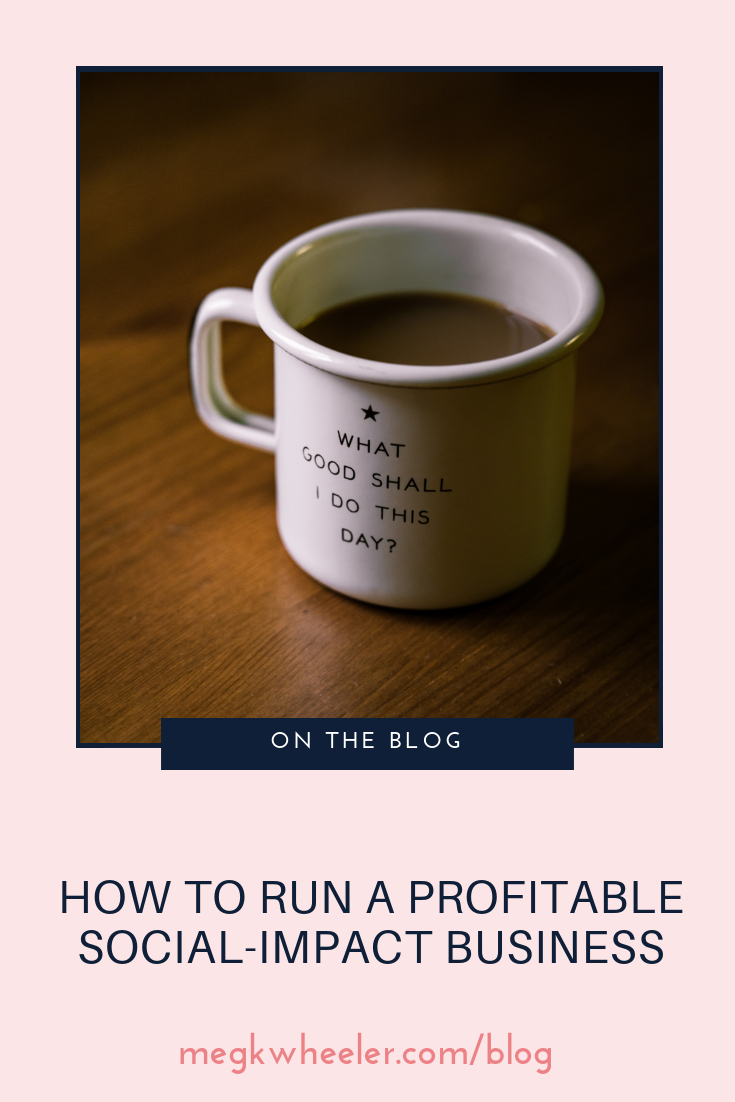How to Run a Profitable Social Impact Business

When I first started my business, One For Women, I knew that I wanted to do more than just make a profit. After spending nearly 10 years in the corporate world, I wanted to have a bigger impact. I figured with a little effort, I could do that in a responsible way.
To back up, let’s talk about the rise of social impact in the business world. It seems that nowadays, being a company that gives back is the current “hot” trend. We see this in many forms – from companies that have a “one-for-one” model (think Toms, who gives a pair of shoes for every pair sold) to companies that only hire and source from certain geographies or populations (think Sudara, whose pajama pants are made by women in India who have escaped sex slavery) to companies that give a portion of their proceeds to non-profits (think Everlane, who gives a portion of their proceeds to organizations like the Human Rights Campaign).
But as the trend of “giving back” as a marketing effort has increased, consumers are increasingly demanding more transparency and authenticity from the brands who are building in a social impact element, to the point where it’s not just enough to say you’re giving back. Brands are having to make giving back at the core of what they do to resonate with their audiences.
Is it possible to incorporate social impact into your model if you’re a small business just trying to make ends meet? As the Co-Founder and CEO of a small startup doing just that, my answer is simple – absolutely. That is, if you do it on your own terms. Here’s how I incorporated social impact into every aspect of One For Women, making a difference while still building a profitable company.
Make it Mean Something
I am a firm believer that you should only do something if you mean it. This definitely extends to being a social impact business. I’ve seen too many companies try to incorporate a “give back” element only to have it fail because their customers just weren’t buying it (or didn’t care). So if you’re considering adding a social impact element to your business, ask yourself these questions:
1. Why do we want to have a social impact element?
2. Does this tie in to the bigger “why” of our company or are we just doing this to increase sales?
3. How will we (or can we?) incorporate this impact into everything we do?
If your social impact component doesn’t tie into the mission of your business, it’s likely that there will be a disconnect between what you are selling and the impact you’re having and your customers will feel that. Whatever your social impact is, it has to be genuine and authentic. It has to tie back into what you, the business, are doing as a whole and what you believe in. At One For Women, we give back to non-profits that support women and girls. This makes sense because our entire mission is about connecting women and supporting women in business. So our social impact reflects that bigger “why.”
Get Your Followers on Board
There’s a simple mantra that I live by in business – if people buy into it, they will pay more for it. This is all the more important when you are talking about a social impact component in your business. Want to give a portion of your proceeds back to non-profits or donate products for every item sold? You’re going to need to factor that cost into your pricing. In many cases, that means you will need to charge more than your competitors. In order to do this, you need to get buy-in from your customers. They’re not going to pay more for it if they don’t buy into the WHY.
So how do you get your customers to buy into the why? First, go after the customers that will care. Look, there are always going to be customers who want the cheapest price and they just aren’t willing to pay more because the fabric was ethically sourced or the labor model supported fair wages and treatment. Those aren’t your customers. There are plenty of people out there who are willing to use their spending power for positive change. Those are the people to go after.
Once you’ve figured out who it is you’re going after, help them play an active role in social change. Using the power of storytelling, images and videos, show your customers why your WHY matters. Show them the power of the impact you’re trying to have. Doing this not only helps them understand the value in what you’re doing, it inspires brand loyalty. They will feel like they are a part of something bigger and more important than themselves.
Focus on Product First, then Cause
Don’t think that having a good cause is enough. If you don’t start with a great product, the impact you’re able to have will be significantly reduced as you lose customers. Start with a quality product that people need and love. Add in a strong brand message to show them your WHY, and they will be a part of the social change you want to have. Fail to give them a product they can get behind? You’re going to lose them before you even have a chance to get them to fall in love with your cause. Why can’t a good cause save the day? Because ultimately, people can donate directly to the cause without your product, if it moves them that much. Show them why partnering with you to support the cause is the better way to go.
Don’t Be Afraid to Make Money
At the end of the day, if you’re a for-profit company, then you need to be a for-profit company. I see this all the time. Businesses that put their desire to affect change over their profits. While this is an honorable gesture, it’s one that will ensure you won’t be a business for much longer. Think about it this way – the longer you are around, the greater the impact you will have. In order to be around longer, you have to make money. So find the balance between making enough money to sustain and grow the business while giving back and having an impact. But don’t ever sacrifice all of your profits for that impact. Even non-profits recognize the need to invest in their work to build their influence.
From a practical perspective, this means building your impact into your profit margin from the beginning. As a small business, while you may not think you have the money to give back, you do if you incorporate it from the beginning. When you’re determining your pricing, figure out what you need to make to include a social impact component while also bringing in a healthy profit to cover costs and invest back in the business. And don’t feel discouraged that your impact in the beginning is too small. Awareness of a cause is just as important to non-profits as every dollar raised.
Create a Win-Win Partnership With Your Non-Profits
Speaking of awareness, recognize that every non-profit organization you work with is the chance for a win-win partnership. While your goal may be to help them through the money you give back, a smart businessperson will recognize the opportunity for increased exposure through their support of your work. Get the non-profit on board with what you’re doing and they will shout from the rooftops to bring you more traffic and hence, more dollars.
At One For Women, we connect with our non-profit organizations from the beginning to share our story and mission with them. We keep them updated the whole way through about the impact we’re having. We are constantly promoting them on our social media and sharing their stories, so that our impact goes beyond the check we write them. In return, they promote us to their audiences – via their social media channels, newsletters and in other campaigns – which drives awareness back to our brand. It’s a win-win for everyone.
The Amount Doesn’t Matter If You’re Transparent
When I first started One For Women, I spent a lot of time stressing about how much of our proceeds to give back. Should it be 1% or 5%? Or profits or proceeds? Or should we do a dollar amount? I honestly had no idea.
And then I met with Elana Reinholtz, the Founder of Bird + Stone, a jewelry company with a mission to “build a more equal world.” A portion of the proceeds from each item they sell is donated to an organization working towards equality – whether that be in the areas of politics, sexual violence, poverty, climate, education or health. When I asked her how she decided how much to give back, she had a very straightforward answer – the amount doesn’t matter as long as you are transparent about it.
Here’s the thing – most customers are not going to nitpick over the percentage of the donation you give. Can you imagine someone saying – “well, I love this dress, but I see they only give 5% back and not 10% so forget it”. Of course not.
What really matters is that you are transparent about what, how much and to whom you are giving. So when you’re considering your social impact, ask yourself these questions:
1. Based on our business model, does it make sense to give product or dollars? Or should we instead focus on the sourcing and production as a way to create impact?
2. If we’re giving product or dollars, what item or amount would make a difference?
3. What would we have to sell our products for in order to donate the answer we came up with in question #2?
4. Do we think that price is reasonable for both the product and the impact we are offering? (market test this!)
5. If not, how can we adjust the price and the impact to choose a more sustainable option?
Don’t be afraid to start out small. If your goal is to do a one-for-one model but you just can’t swing that at the beginning, maybe start with a portion of proceeds. You can always change your impact as you grow. As long as you are transparent about it and as long as the change aligns with your mission.
In the end, whether or not you have a social impact aspect to your business is your choice. But if you do, it should be aligned with your WHY. It should be genuine and authentic, and above all, you need to be transparent about it. Companies both big and small have the power to enact radical change, and being a social impact company is a privilege and an honor, but with it you yield great power, so use it wisely.
